How Long To Cook A Turkey Without Stuffing
Follow these basic steps for how to cook a turkey and you will enjoy a tender, juicy turkey without fail.
Cooking a turkey for Thanksgiving dinner or a Sunday dinner doesn't have to be overwhelming. With these simple steps you can have a full turkey dinner, complete with mashed potatoes, gravy and stuffing for any occasion without breaking a sweat!
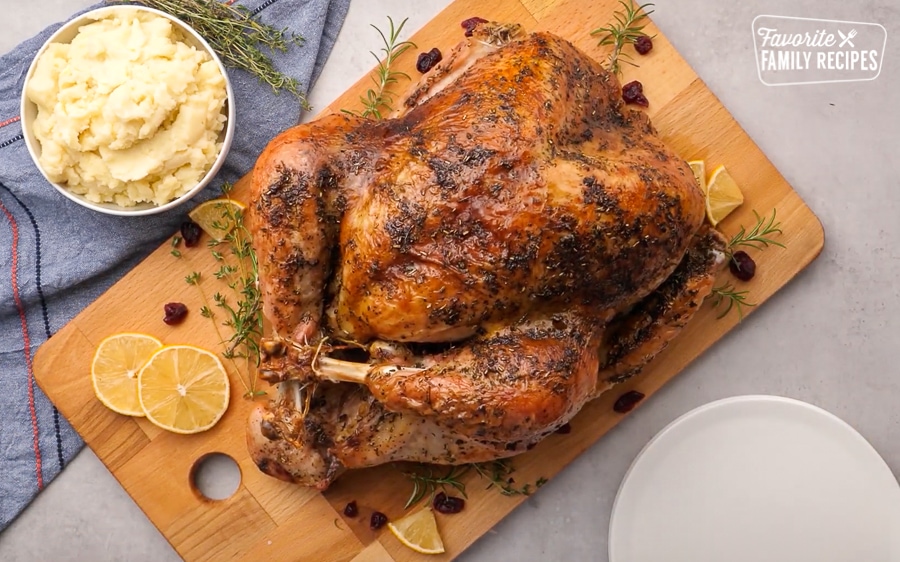
How To Cook A Turkey
Whether it's the first time or tenth time you are cooking a turkey, there is something that can be slightly intimidating about it. Will it be cooked in time? Am I going to have enough turkey? Will it be dry? Take a deep breath and be assured that you can do this! Follow this recipe along with the guidelines we've included, and you will be placing a flavorful, moist, and tender turkey on the kitchen table for all to admire.
To start off, here are some items to consider when purchasing a turkey, thawing a frozen turkey, and planning for cooking time.
How many pounds of turkey do I need?
This is a key question to ask when preparing a turkey for Thanksgiving or a Sunday dinner. You definitely don't want to run out of turkey during dinner, and you need turkey leftovers for turkey sandwiches, turkey pot pie, and turkey noodle soup, right? A good rule of thumb when buying a turkey, if you want leftovers, is 1 1/2 pounds of turkey per person. This takes into account the weight of the bones, it's not all meat weight. If you don't want a lot of leftover turkey meat, estimate 1 pound of meat per person. I like leftover turkey, so if I'm serving 12 people at Thanksgiving dinner, I will buy an 18 pound turkey.
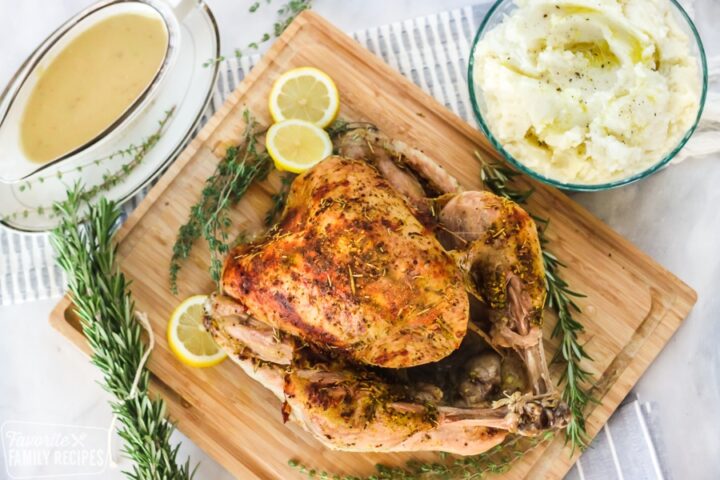
How long do I thaw a frozen turkey?
For food safety, and thorough cooking, a turkey should be completely thawed before it is cooked. To slow thaw a turkey, place it in the refrigerator for 3-6 days prior to cooking. This is a great, safe way to thaw your turkey and how we recommend thawing. The chart below shows when to thaw your turkey for Thanksgiving 2021.

How To Quick Thaw a Turkey (aka Cold Water Thawing)
We have all waited until the last minute to thaw the turkey (or forgot to thaw it). I have done it (several times actually) and we get comments and emails every year from others who have done it. Don't worry, there is a quick-thaw solution that the USDA actually approves of. This is the "Cold Water Thaw". To do this you will want to allow 30 minutes of thaw time per pound of turkey. Here is what the USDA recommends:
"First, be sure the turkey is in a leak-proof plastic bag to prevent cross-contamination and to prevent the turkey from absorbing water, resulting in a watery product.
Submerge the wrapped turkey in cold tap water. Change the water every 30 minutes until the turkey is thawed. Cook the turkey immediately after it is thawed."
COLD WATER THAWING TIMES
- 4 to 12 pounds — 2 to 6 hours
- 12 to 16 pounds — 6 to 8 hours
- 16 to 20 pounds — 8 to 10 hours
- 20 to 24 pounds — 10 to 12 hours
Should I Rinse My Turkey?
In short, NO. According to the USDA, rinsing your turkey is not only unnecessary, but could actually do more harm than good. Rinsing your turkey can splash and spread bacteria into your sink and on your countertops. Instead, drain the excess juices from the turkey down the sink and then pat the turkey dry with paper towels.
Brining
We typically don't brine our turkey because 1. we put so many seasonings, herbs, and butter on our turkey, it really doesn't need it and 2. it just adds an extra step and takes up a lot of refrigerator space. However, many people love to do a turkey brine and there is nothing wrong with that. It can definitely add more flavor and can help crisp up the skin. The best wet brining resource we have found comes straight from the USDA (here). They have great tips on how to safely brine a whole turkey. They also have some great tips for dry brining with Kosher salt here.

Seasoning
For this recipe we like to use plenty of butter (you can use salted or unsalted butter) and traditional seasonings such as parsley, sage, rosemary, and thyme. Remember to pat the turkey very dry before adding butter and seasonings so they adhere to the turkey while cooking. You can also throw some lemon or orange slices onto the turkey while it is roasting to give it a little citrus-y boost.
What temperature to cook a turkey?
Low and slow is the name of the game when it comes to cooking a turkey. A lower heat and longer cooking time results in tender, juicy turkey meat that is worth the wait. We've found that 325 degrees Fahrenheit is ideal for a Thanksgiving turkey. See the chart below for cooking time.
How long to cook a turkey?
This is the crucial question when preparing Thanksgiving dinner! Timing is everything! The cooking time depends on the size of the turkey, and it's important to remember that all ovens are not created equal. This is why a meat thermometer is essential. This chart will help give you an idea of how long to cook your turkey, but keep in mind that all ovens are not created equal. Keep in mind that the turkey will also need to rest once it is out of the oven for 20-30 minutes. This allows the juices to distribute throughout the turkey before it is sliced. This will give you time to bake the rolls, make the gravy, and finish up side dishes.
Approximate Turkey Cooking Times from USDA
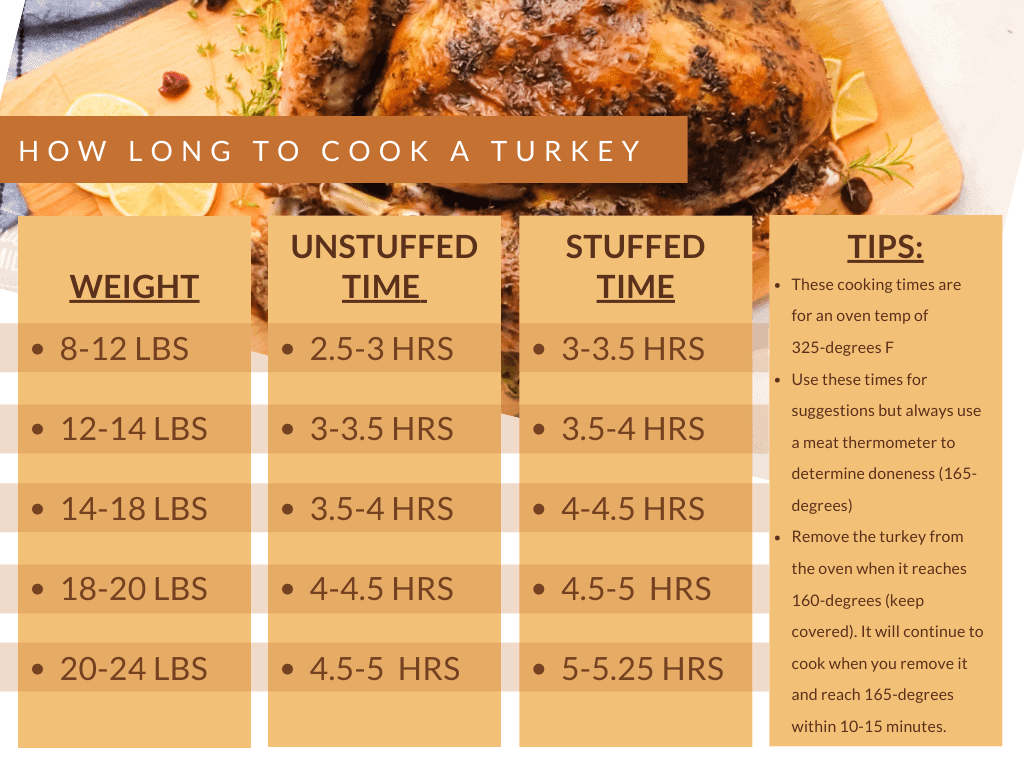
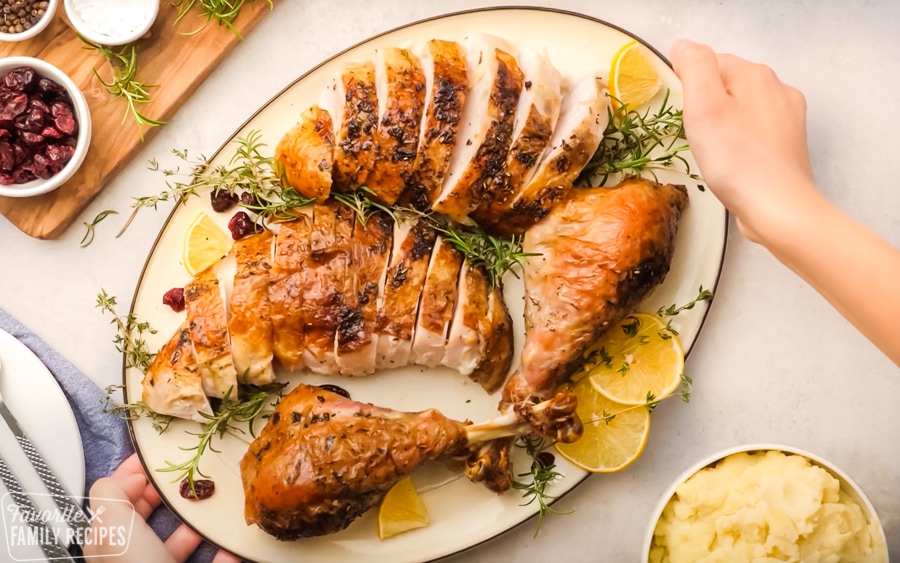
Meat Thermometer Guidelines from the National Turkey Federation
This is the recommendation from the National Turkey Federation for meat thermometer placement and internal temperatures:
Proper Placement of Meat Thermometer in Turkey
An important part of using any thermometer is the proper placement in the turkey.
- Insert the thermometer 2 1/2 inches in the deepest, thickest part of the breast or into the inner thigh near the turkey breast.
- Make sure the thermometer does not touch a bone.
- When inserting the thermometer in the turkey breast, insert it from the side.
- The thermometer is easier to read and more accurate than when inserted from the top.
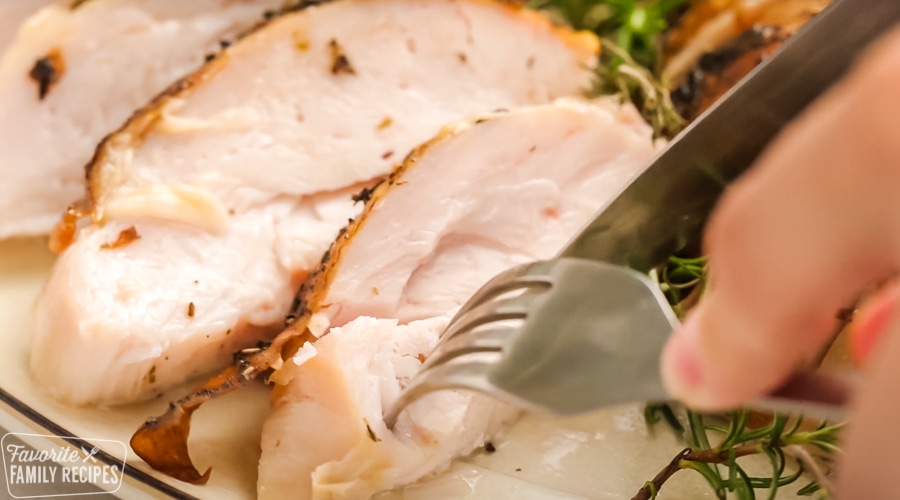
Internal Temperature
The internal temperature should reach:
- 165 degrees F to 170 degrees F in the breast
- 175 degrees F to 180 degrees F in the thigh and
- 165 degrees F in the center of the stuffing.
More Tips For Cooking a Turkey
- Use a good roasting pan. We use a Magnalite roasting pan. It's what our mom has used for years. We call it the "magic pot". Any deep-walled, heavy duty roasting pan will work great though.
- Use a roasting rack. This will make it so your turkey isn't sitting down in the juices. You don't want to have a turkey with a soggy bottom. A roasting rack will also make it so the turkey gets a good "crackling" all the way around.
- If you can't cover the turkey with a lid, cover with aluminum foil.
- Use an electric knife for carving. It just makes it so much easier to carve. If you don't have an electric knife, be sure to use a very sharp knife so you don't tear up the meat.
- If you want to add vegetables in with your turkey, you can add them before you place the turkey in the oven but this could make them soggy. We usually don't add vegetables to our roasted turkey, but if you prefer adding veggies, such as carrots, onions, celery, or even potatoes, we recommend adding them only an hour or two before the turkey is finished cooking.
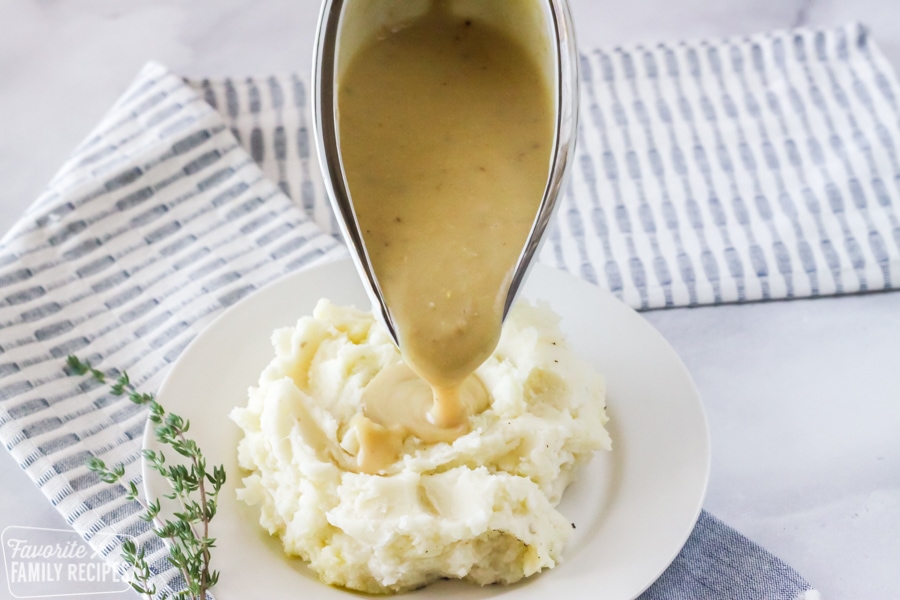
How to Make Turkey Gravy
What is a delicious roasted turkey without the gravy? The gravy is the icing on the cake when it comes to turkey. The flavorful drippings from the turkey are what make the gravy! Use our Mom's Famous Turkey Gravy recipe for the best tasting turkey gravy made from turkey drippings.
What To Serve With Turkey
Whether you are cooking a turkey for Thanksgiving or for Sunday dinner, you can't go wrong with any of these delicious side dishes:
-
![Mashed potatoes in a bowl with butter]()
Perfect Mashed Potatoes (How To Make Mashed Potatoes) -
![Cranberry Orange sauce with fresh cranberries and oranges on the side]()
Cranberry Orange Sauce -
![Soft buttery dinner rolls in a basket with a decorative cloth]()
The Best Homemade Dinner Rolls -
![Cranberry Sausage Stuffing in a white bowl with a wooden spoon next to it]()
Cranberry Sausage Stuffing
Here are some more great sides and Thanksgiving dinner ideas:
- Creamed corn
- Sautéed asparagus
- Sautéed Peas
- Raspberry Cranberry Sauce
- Harvest Pear Salad with Cranberry Vinaigrette Dressing
- The BEST Sweet Potato Casserole with Coconut Pecan Topping
- 25+ Recipes for Thanksgiving Dinner
How to Cook a Turkey

Follow these easy steps and guidelines for How to Cook a Turkey. Cooking time and serving size are for an 18 pound turkey. See chart in post above for cooking times for smaller and larger turkeys.
Prep Time: 20 minutes
Cook Time: 4 hours
Resting Time: 30 minutes
Total: 4 hours 20 minutes
Serves: 12
- 1 whole turkey thawed (18-20 lbs)
- thick celery stalks and onion slices (optional, see steps 2 and 3)
- 1/3 cup salted butter
- 1 cup chicken broth
- 1 teaspoon parsley
- 1 teaspoon sage
- 1 teaspoon rosemary
- 1 teaspoon thyme
- aluminum foil
-
Preheat oven to 325 degrees. Remove turkey from packaging. Remove any giblets or gravy packets included with the turkey. Throw the neck and giblets away. Keep the gravy packet in the refrigerator until you make the gravy (turkey gravy recipe in recipe notes). Pat completely dry with paper towels (this is important so the butter will adhere to the turkey).
![Drying a turkey to prep for cooking]()
-
Spray a roasting pan with cooking spray. Add the chicken broth to the bottom of the pan then place the turkey on a wire roasting rack inside the pan. Thick celery stocks and thick onion slices can be used instead of a wire rack.
Note: If using an aluminum roasting pan, do not place the turkey directly on the aluminum. Place some thick celery stocks and thick onion slices in the bottom of the pan, and place the turkey on top of them. If the turkey is placed directly on the pan, the skin will stick to the bottom of the pan as the turkey cooks and the turkey will be difficult to remove from the pan.
![]()
-
Tuck the wing tips under the bird so that they will not get too brown while cooking. This also looks much more appetizing.
![Turkey wings being tucked under a raw turkey prior to cooking]()
-
Melt butter and brush evenly over the turkey. Gently lift the skin and rub some of the butter under the skin layer.
![A raw, whole turkey being basted with melted butter and herbs]()
-
Combine the spices and rub them evenly over the buttered turkey.
![Herbs being sprinkled on a raw turkey in a roasting pan]()
-
Make an aluminum foil "tent" to go over the entire turkey. Using a wide aluminum foil sheet, or two long sheets crimped together to form a wide sheet, loosely cover the entire turkey. Tuck the foil inside the roasting pan around the turkey so the condensation from the turkey drips from the foil back into the pan.
![Placing foil over turkey for cooking]()
-
Place the turkey in the oven and cook according to turkey package directions. Cooking time will vary according to the turkey size. See turkey cooking chart in post above. A meat thermometer is always recommended. A turkey is fully cooked when the internal temperature reaches 170 degrees. If the turkey has been "stuffed" with dressing, add 15-45 minutes to the cooking time. The dressing, or stuffing, is fully cooked when it reaches 165 degrees in the center of the dressing.
![]()
-
Remove the foil tent after one hour of cooking. The foil keeps the moisture in the turkey. As the skin browns, it thickens and will do the job of keeping the moisture in without the foil. If the turkey is getting too brown near the end of the cooking time, replace the foil tent.
![]()
-
Once the turkey reaches 170 degrees, remove it from the oven and allow it to rest for at least 20 minutes, and up to 40 minutes before carving. This allows the juices to redistribute through the meat.
![Fully cooked turkey on a cutting board]()
-
While the turkey is resting, make turkey gravy. See the link to "How to Make Turkey Gravy" in the recipe notes below.
![Turkey Gravy in a Serving Dish]()
-
Carve and slice. Enjoy a moist, delicious turkey!
![Sliced turkey on a platter.]()
Because of the butter on the turkey, there is no need to baste the turkey while it cooks. The aluminum foil tent also keeps moisture in the turkey. Once the skin browns, it thickens and keeps the moisture in.
See How to Make Turkey Gravy for a delicious turkey gravy to serve with your turkey.
Calories: 349 kcal | Carbohydrates: 1 g | Protein: 47 g | Fat: 17 g | Saturated Fat: 6 g | Cholesterol: 168 mg | Sodium: 357 mg | Potassium: 496 mg | Fiber: 1 g | Sugar: 1 g | Vitamin A: 285 IU | Vitamin C: 1.7 mg | Calcium: 27 mg | Iron: 1.9 mg
Course: Main Course, Dinner
Cuisine: American
How to Cook a Turkey
Recipe by: Echo Blickenstaff
How Long To Cook A Turkey Without Stuffing
Source: https://www.favfamilyrecipes.com/how-to-cook-a-turkey/
Posted by: fawcettanob1951.blogspot.com

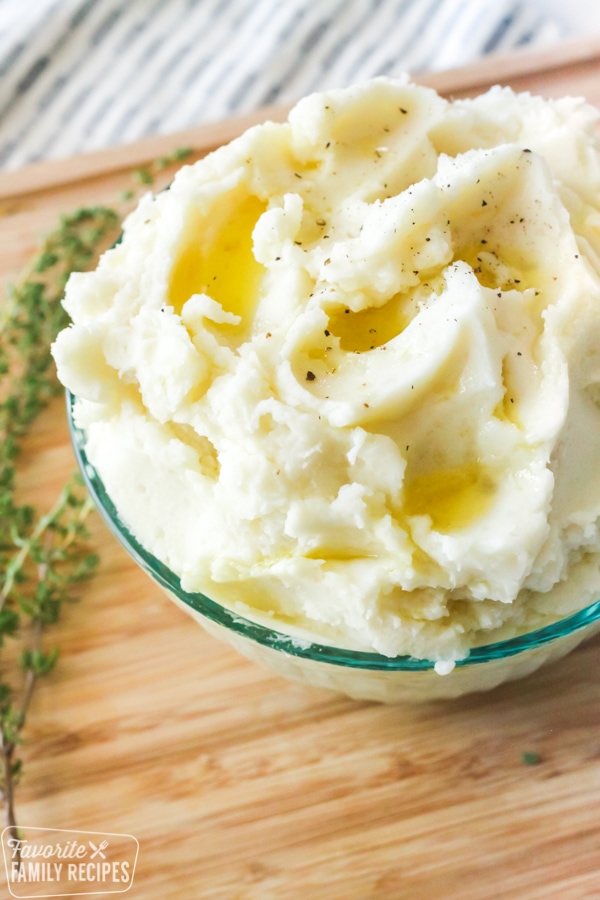
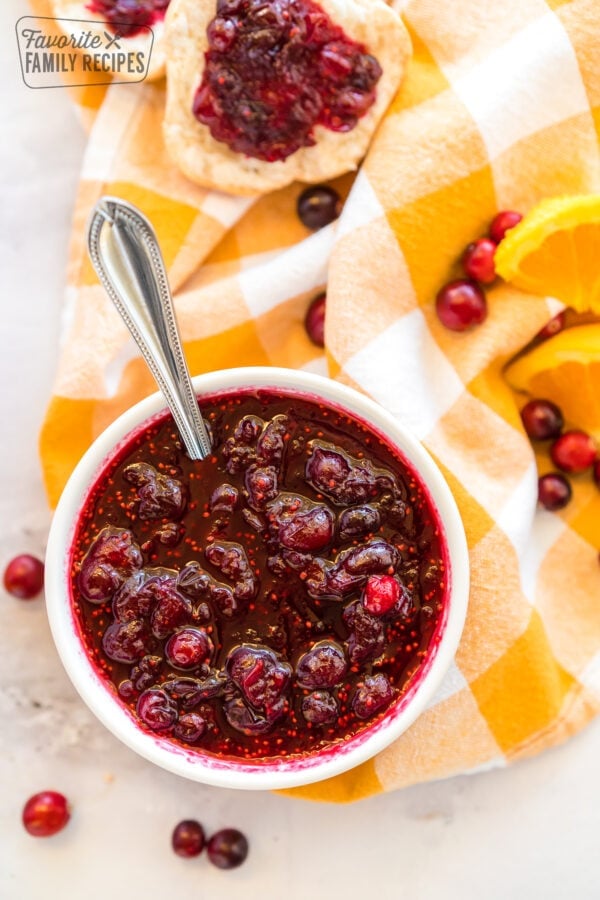
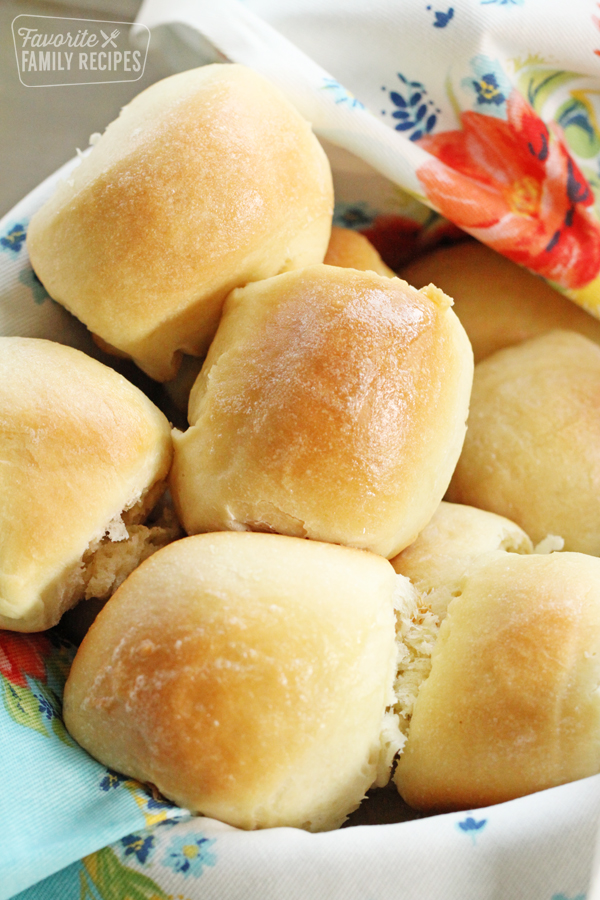
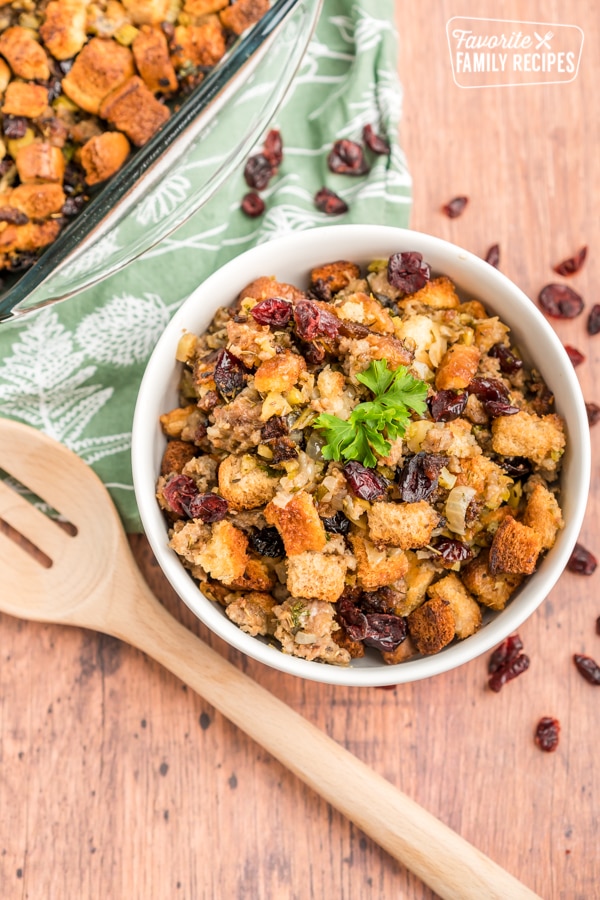


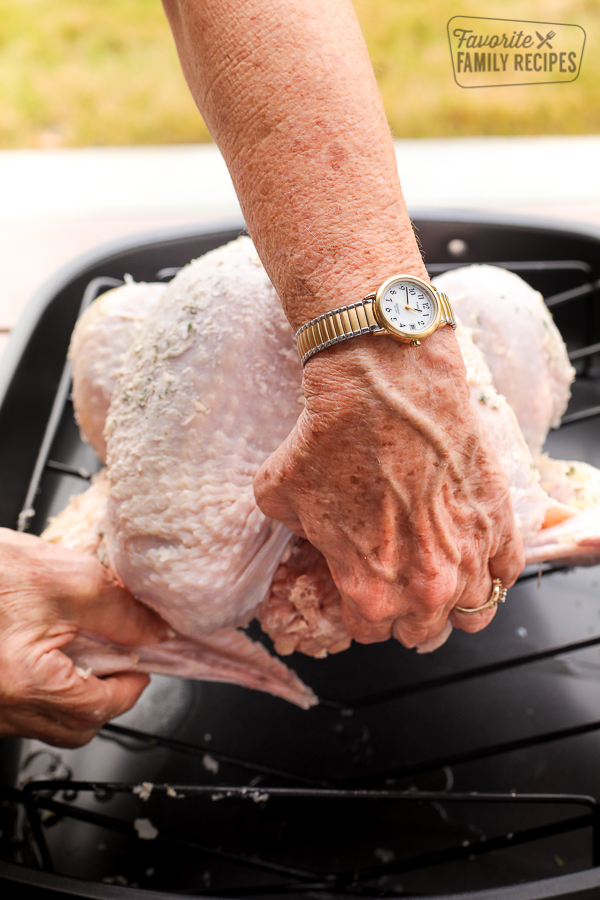
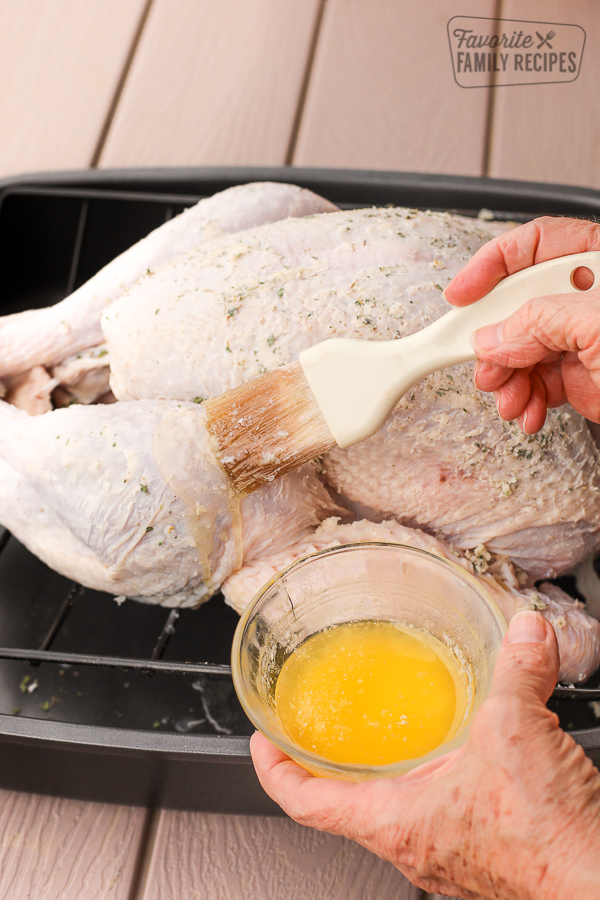
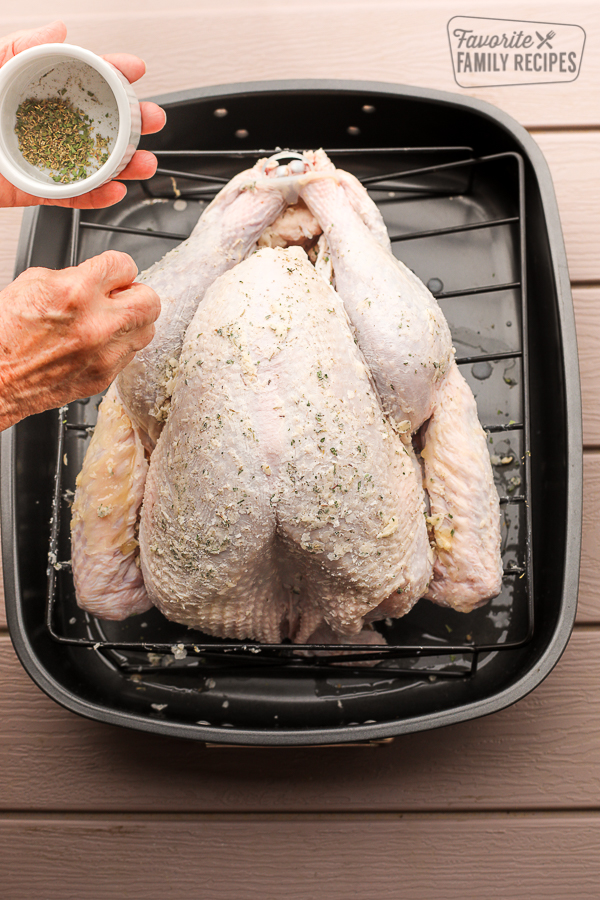




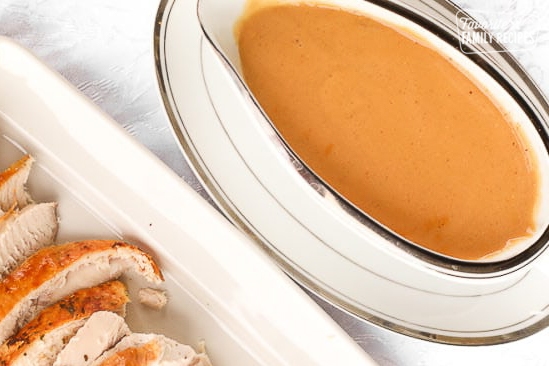

0 Response to "How Long To Cook A Turkey Without Stuffing"
Post a Comment